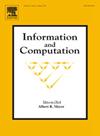用于学习系统环境的自动机分解
IF 0.8
4区 计算机科学
Q3 COMPUTER SCIENCE, THEORY & METHODS
引用次数: 0
摘要
本文章由计算机程序翻译,如有差异,请以英文原文为准。
An automaton decomposition for learning system environments
A finite automaton two-component cascade decomposition is presented in which the first component has a synchronizer and the second component is a permutation automaton. The synchronizer corresponds to a primitive idempotent element e in the transition monoid M of the automaton. The state set of the second component is the range of e; each state of the first component is an image of this range under one of the transitions in M. The transition monoid of the second component is the group eMe. as a conceptual tool, the decomposition can be used to clarify the credit assignment problems faced by learning system reward schemes in finite automaton environments.
求助全文
通过发布文献求助,成功后即可免费获取论文全文。
去求助
来源期刊

Information and Computation
工程技术-计算机:理论方法
CiteScore
2.30
自引率
0.00%
发文量
119
审稿时长
140 days
期刊介绍:
Information and Computation welcomes original papers in all areas of theoretical computer science and computational applications of information theory. Survey articles of exceptional quality will also be considered. Particularly welcome are papers contributing new results in active theoretical areas such as
-Biological computation and computational biology-
Computational complexity-
Computer theorem-proving-
Concurrency and distributed process theory-
Cryptographic theory-
Data base theory-
Decision problems in logic-
Design and analysis of algorithms-
Discrete optimization and mathematical programming-
Inductive inference and learning theory-
Logic & constraint programming-
Program verification & model checking-
Probabilistic & Quantum computation-
Semantics of programming languages-
Symbolic computation, lambda calculus, and rewriting systems-
Types and typechecking
 求助内容:
求助内容: 应助结果提醒方式:
应助结果提醒方式:


